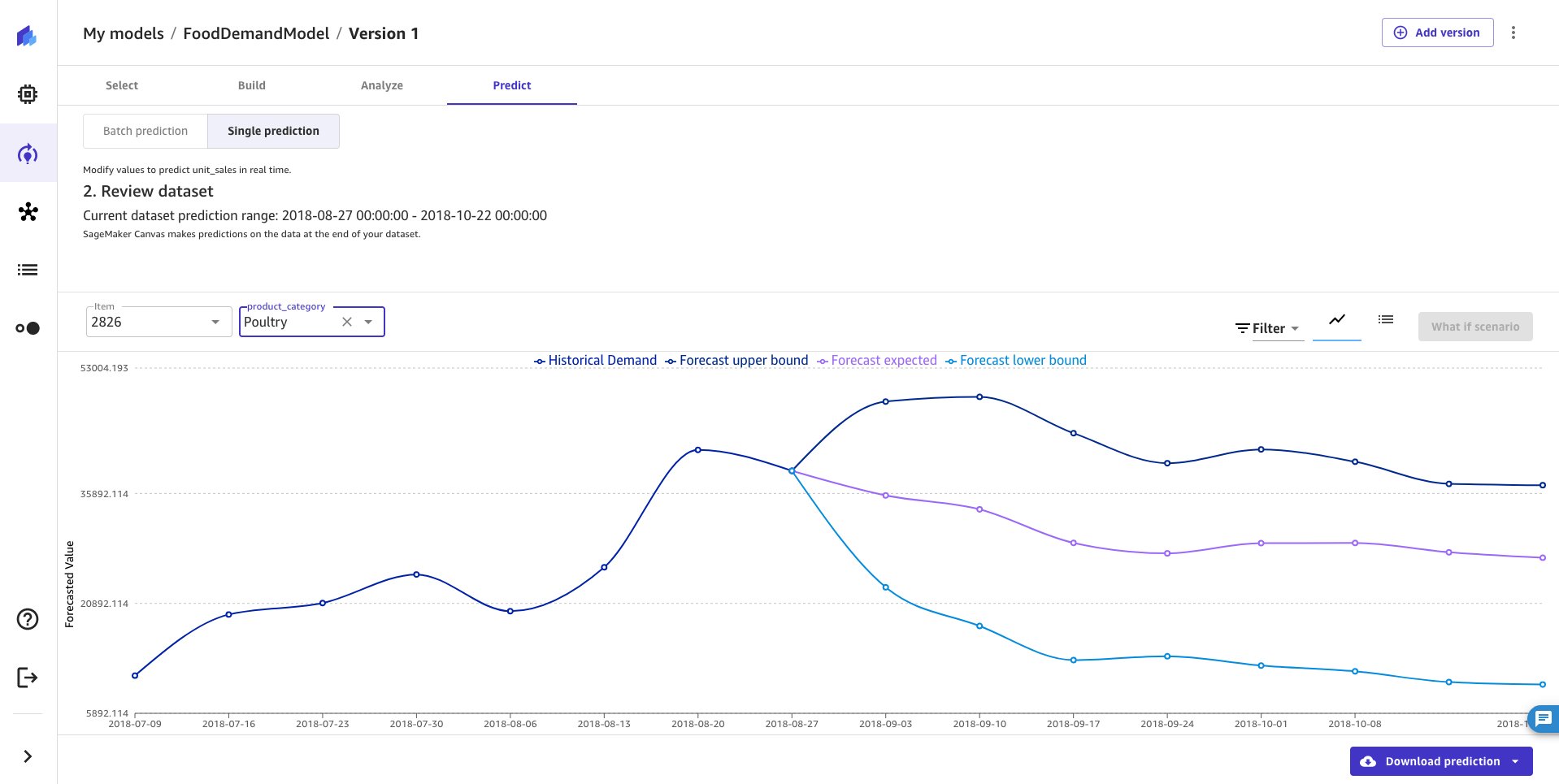We’re excited to announce that Amazon SageMaker Canvas now offers a quicker and more user-friendly way to create machine learning models for time-series forecasting. SageMaker Canvas is a visual point-and-click service that enables business analysts to generate accurate machine learning (ML) models without requiring any machine learning experience or having to write a single line of code.
SageMaker Canvas supports a number of use cases, including time-series forecasting used for inventory management in retail, demand planning in manufacturing, workforce and guest planning in travel and hospitality, revenue prediction in finance, and many other business-critical decisions where highly-accurate forecasts are important. As an example, time-series forecasting allows retailers to predict future sales demand and plan for inventory levels, logistics, and marketing campaigns. Time-series forecasting models in SageMaker Canvas use advanced technologies to combine statistical and machine learning algorithms, and deliver highly accurate forecasts.
In this post, we describe the enhancements to the forecasting capabilities of SageMaker Canvas and guide you on using its user interface (UI) and AutoML APIs for time-series forecasting. While the SageMaker Canvas UI offers a code-free visual interface, the APIs empower developers to interact with these features programmatically. Both can be accessed from the SageMaker console.
Improvements in forecasting experience
With today’s launch, SageMaker Canvas has upgraded its forecasting capabilities using AutoML, delivering up to 50 percent faster model building performance and up to 45 percent quicker predictions on average compared to previous versions across various benchmark datasets. This reduces the average model training duration from 186 to 73 minutes and the average prediction time from 33 to 18 minutes for a typical batch of 750 time series with data size up to 100 MB. Users can now also programmatically access model construction and prediction functions through Amazon SageMaker Autopilot APIs, which come with model explainability and performance reports.
Previously, introducing incremental data required retraining the entire model, which was time-consuming and caused operational delays. Now, in SageMaker Canvas, you can add recent data to generate future forecasts without retraining the entire model. Just input your incremental data to your model to use the latest insights for upcoming forecasts. Eliminating retraining accelerates the forecasting process, allowing you to more quickly apply those results to your business processes.
With SageMaker Canvas now using AutoML for forecasting, you can harness model building and prediction functions through SageMaker Autopilot APIs, ensuring consistency across the UI and APIs. For example, you can start with building models in the UI, then switch to using APIs for generating predictions. This updated modeling approach also enhances model transparency in several ways:
- Users can access an explainability report that offers clearer insights into factors influencing predictions. This is valuable for risk, compliance teams, and external regulators. The report elucidates how dataset attributes influence specific time series forecasts. It employs impact scores to measure each attribute’s relative effect, indicating whether they amplify or reduce forecast values.
- You can now access the trained models and deploy them to SageMaker Inference or your preferred infrastructure for predictions.
- A performance report is available, granting deeper insights into optimal models chosen by AutoML for specific time series and the hyperparameters used during training.
Generate time-series forecasts using the SageMaker Canvas UI
The SageMaker Canvas UI lets you seamlessly integrate data sources from the cloud or on-premises, merge datasets effortlessly, train precise models, and make predictions with emerging data—all without coding. Let’s explore generating a time-series forecast using this UI.
First, you import data into SageMaker Canvas from various sources, including from local files from your computer, Amazon Simple Storage Service (Amazon S3) buckets, Amazon Athena, Snowflake, and over 40 other data sources. After importing data, you can explore and visualize it to get additional insights, such as with scatterplots or bar charts. After you’re ready to create a model, you can do it with just a few clicks after configuring necessary parameters, such as selecting a target column to forecast and specifying how many days into the future you want to forecast. The following screenshots show an example visualization of predicting product demand based on historical weekly demand data for specific products in different store locations:

The following image shows weekly forecasts for a specific product in different store locations:

For a comprehensive guide on how to use the SageMaker Canvas UI for forecasting, check out this blog post.
If you need an automated workflow or direct ML model integration into apps, our forecasting functions are accessible through APIs. In the following section, we provide a sample solution detailing how to employ our APIs for automated forecasting.
Generate time-series forecast using APIs
Let’s dive into how to use the APIs to train the model and generate predictions. For this demonstration, consider a situation where a company needs to predict product stock levels at various stores to meet customer demand. At a high level, the API interactions break down into the following steps:
- Prepare the dataset.
- Create a SageMaker Autopilot job.
- Evaluate the Autopilot job:
- Explore the model accuracy metrics and backtest results.
- Explore the model explainability report.
- Generate predictions from the model:
- Use the real-time inference endpoint created as part of the Autopilot job; or
- Use a batch transform job.

Sample Amazon SageMaker Studio notebook showcasing forecasting with APIs
We’ve provided a sample SageMaker Studio notebook on GitHub to help accelerate your time-to-market when your business prefers to orchestrate forecasting through programmatic APIs. The notebook offers a sample synthetic dataset available through a public S3 bucket. The notebook guides you through all the steps outlined in the workflow image mentioned above. While the notebook provides a basic framework, you can tailor the code sample to fit your specific use case. This includes modifying it to match your unique data schema, time-resolution, forecasting horizon, and other necessary parameters to achieve your desired results.
Conclusion
SageMaker Canvas democratizes time-series forecasting by offering a user-friendly, code-free experience that empowers business analysts to create highly accurate machine learning models. With today’s AutoML upgrades, it delivers up to 50 percent faster model building, up to 45 percent quicker predictions, and introduces API access for both model construction and prediction functions, enhancing its transparency and consistency. The unique ability of SageMaker Canvas to seamlessly handle incremental data without retraining ensures swift adaptation to ever-changing business demands.
Whether you prefer the intuitive UI or versatile APIs, SageMaker Canvas simplifies data integration, model training, and prediction, making it a pivotal tool for data-driven decision-making and innovation across industries.
To learn more, review the documentation, or explore the notebook available in our GitHub repository. Pricing information for time-series forecasting using SageMaker Canvas is available on the SageMaker Canvas Pricing page, and for SageMaker training and inference pricing when using SageMaker Autopilot APIs please see the SageMaker Pricing page.
These capabilities are available in all AWS Regions where SageMaker Canvas and SageMaker Autopilot are publicly accessible. For more information about Region availability, see AWS Services by Region.
About the Authors
 Nirmal Kumar is Sr. Product Manager for the Amazon SageMaker service. Committed to broadening access to AI/ML, he steers the development of no-code and low-code ML solutions. Outside work, he enjoys travelling and reading non-fiction.
Nirmal Kumar is Sr. Product Manager for the Amazon SageMaker service. Committed to broadening access to AI/ML, he steers the development of no-code and low-code ML solutions. Outside work, he enjoys travelling and reading non-fiction.
 Charles Laughlin is a Principal AI/ML Specialist Solution Architect who works on the Amazon SageMaker service team at AWS. He helps shape the service roadmap and collaborates daily with diverse AWS customers to help transform their businesses using cutting-edge AWS technologies and thought leadership. Charles holds a M.S. in Supply Chain Management and a Ph.D. in Data Science.
Charles Laughlin is a Principal AI/ML Specialist Solution Architect who works on the Amazon SageMaker service team at AWS. He helps shape the service roadmap and collaborates daily with diverse AWS customers to help transform their businesses using cutting-edge AWS technologies and thought leadership. Charles holds a M.S. in Supply Chain Management and a Ph.D. in Data Science.
 Ridhim Rastogi a Software Development Engineer who works on Amazon SageMaker service team at AWS. He is passionate about building scalable distributed systems with a focus on solving real-world problems through AI/ML. In his spare time, he likes to solve puzzles, read fiction, and explore his surroundings.
Ridhim Rastogi a Software Development Engineer who works on Amazon SageMaker service team at AWS. He is passionate about building scalable distributed systems with a focus on solving real-world problems through AI/ML. In his spare time, he likes to solve puzzles, read fiction, and explore his surroundings.
 Ahmed Raafat is a Principal Solutions Architect at AWS, with 20 years of field experience and a dedicated focus of 5 years within the AWS ecosystem. He specializes in AI/ML solutions. His extensive experience extends across various industry verticals, rendering him a trusted advisor for numerous enterprise customers, facilitating their seamless navigation and acceleration of their cloud journey.
Ahmed Raafat is a Principal Solutions Architect at AWS, with 20 years of field experience and a dedicated focus of 5 years within the AWS ecosystem. He specializes in AI/ML solutions. His extensive experience extends across various industry verticals, rendering him a trusted advisor for numerous enterprise customers, facilitating their seamless navigation and acceleration of their cloud journey.
 John Oshodi is a Senior Solutions Architect at Amazon Web Services based in London, UK. He specializes in data and analytics and serves as a technical advisor for numerous AWS enterprise customers, supporting and accelerating their cloud journey. Outside of work, he enjoys travelling to new places and experiencing new cultures with his family.
John Oshodi is a Senior Solutions Architect at Amazon Web Services based in London, UK. He specializes in data and analytics and serves as a technical advisor for numerous AWS enterprise customers, supporting and accelerating their cloud journey. Outside of work, he enjoys travelling to new places and experiencing new cultures with his family.
